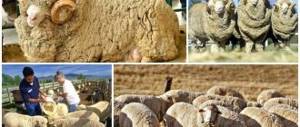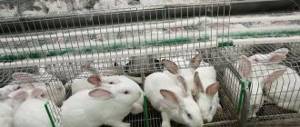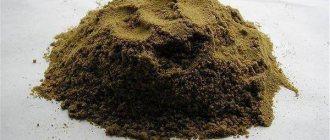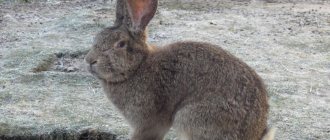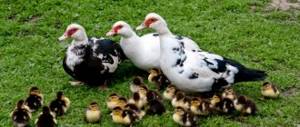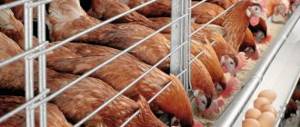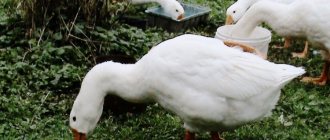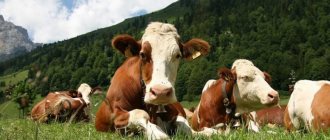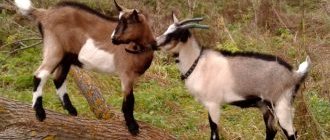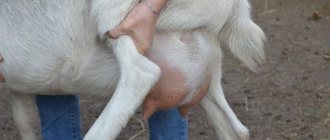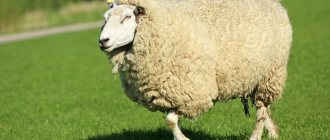Main breeds of farm animals.
Breed serves as the taxonomic unit adopted for classifying farm animals. Breeds arose as a result of the creative activity of man, who, using the heredity and variability of organisms, created significant groups of animals that were similar in direction and level of productivity and other economic and biological properties, and maintained these properties through systematic selection and selection.The breed differs from the population of wild animals in its structure, as well as in the fact that it is bred under human control. With some diversity in its constituent individuals, the breed as a whole is characterized by properties and qualities common to it.
E.Ya. Borisenko gives the following definition of a breed: “... a breed in zootechnics should be understood as an integral group of domestic animals of the same species, of common origin, characterized by specific morphophysiological and economically useful properties and certain requirements for living conditions, which are inherited, distinguishing it from another similar group and are supported by breeding work.” This definition ticks all the boxes. main characteristics of the breed. The breed must have a large enough number of animals to be able to keep them for a long period. breed without resorting to forced inbreeding. D.A. Kislovsky believes that the breed should have at least 4,500 queens and 150 sires.
Minimum breed size requirements depend on the type of animal. At the same time, they take into account the fertility of queens, the speed of generational change, the quantity and quality of high-value breeders and queens, family ties between them, and reproduction techniques. With artificial insemination, the breed should be more numerous.
When classifying breeds, the following main indicators are taken into account: the area (distribution) of the breed, the direction of productivity, the quantity and quality of labor spent on its creation and improvement.
The range of breeds is largely determined by their numbers. Numerous breeds are usually widespread in different countries and zones. They are called wide range breeds. These breeds include black-and-white, red, pale-and-white and brown breeds of cattle; large white and some other breeds of pigs.
Small breeds are bred in a small area, i.e. their range is limited, which is why they are often called local (for example, Yaroslavl, Red Gorbatov, Red Tambov, etc.) cattle breeds.
The breed's range is also determined by its ability to adapt to different climatic conditions without significantly reducing productivity.
Breeds of farm animals are differentiated according to the direction of productivity. In cattle breeding, for example, dairy, meat and dual productivity breeds (dairy-meat, meat-dairy) are distinguished; in horse breeding - riding, light-draft, heavy-duty and local universal; in sheep breeding - fine-fleece, semi-fine-fleece, semi-coarse-wool and coarse-wool; in goat breeding - milk, down; in pig farming - tallow, all-purpose and meat (bacon).
The direction of a breed’s productivity is taken into account when choosing it for breeding in the specific natural and economic conditions of a zone. Dairy cattle breeds are bred primarily in areas of intensive dairy farming located near large cities and industrial centers. Where milk production is combined with meat production, dairy and meat breeds are used, and in areas of beef cattle breeding, meat breeds are used.
Depending on the amount of labor spent on creating the breed, as well as on the level of its consolidation, productivity and breeding qualities, breeds are distinguished: factory (cultivated), transitional and primitive.
Factory breeds are distinguished by good type expression, high productivity and breeding qualities. Such breeds were created as a result of systematic, long-term, targeted artificial selection and selection of animals using progressive breeding methods. They are characterized by consolidated heredity and pass on their qualities well to offspring. Among the factory breeds of cattle bred in the USSR, we can name the Black-and-White, Kholmogory, Red Steppe, Baltic red breeds, Jersey, Ayrshire, brown breeds of Swiss origin, Simmental and Sychevsky, Hereford, Charolais, Aberdeen-Angus; from breeds of pigs - large white, landrace, Urzhum, Estonian bacon and Latvian large; of sheep breeds - Askanian, Altai, North Caucasian, Prekos, Romney Marsh, Tsygai, Romanov, Karakul; from horse breeds - thoroughbred riding, Oryol trotter, Vladimir heavy draft and some others.
Primitive breeds are represented mainly by local animals; They are common in less intensive livestock farming areas. Such breeds were formed under the significant influence of natural selection. Zootechnical and breeding work with animals of such breeds is at a low level. Primitive breeds include Yakut, Tuvan, Buryat cattle, Tuvan sheep, Yakut horses.
Despite their low productivity, animals of primitive breeds are distinguished by some valuable properties - endurance and adaptability to harsh natural conditions, developed in them under the influence of natural selection over generations. In the strict sense of the word, they are not breeds, since they lack the qualities characteristic of the breed. Therefore, in cattle breeding, in such cases, they often talk about local cattle, in sheep breeding - about local sheep, in horse breeding - about local horses, meaning by them animal populations that have developed in certain zones.
Transitional breeds in terms of type consolidation, productivity and breeding qualities occupy an intermediate position between factory and primitive ones. These breeds have been largely exposed to artificial selection, but have not yet achieved the qualities characteristic of factory breeds. As artificial selection influences and the breeding and productive qualities of animals are improved, transitional breeds acquire the significance of factory breeds. There is no clear boundary and list of conditions under which a transitional breed can be classified as a factory breed. The main indicator can be taken as the ability of breeding animals of a breed to pass on their qualities to offspring when mating with animals of another breed.
Among the domestic breeds, the transitional ones include the Istobensky, Yurinsky breeds of cattle, as well as Suksun cattle.
Cattle
There are about 250 breeds of cattle (cattle) in the world. Based on various characteristics, they are grouped into several groups. There are 3 classifications of livestock breeds: craniological; economic; geographical.
According to the first, based on differences in the structure of the skull, the following types of cattle are distinguished:
· Narrow-browed, which includes the Dutch, Kholmogory, gray Ukrainian, Yaroslavl, Tagil, red steppe, etc.;
· Lobasty - Simmental and all its derivatives;
· Short-horned - Swiss, Jersey, Kostroma, Lebedinskaya, etc.;
· Short-headed - Tyrolean, Hereford, red Gorbatov, Kazakh white-headed, etc.;
· Straight-horned - Kalmyk, Mongolian cattle.
· In addition, there is a polled type - all hornless breeds of Northern Europe.
The economic classification is based on the predominant productivity of animals. Among the breeds of dairy production, the most widespread in many countries is the Dutch Black-and-White; in some countries it is known as Holstein-Friesian (Canada, Japan, USA) or Friesian (Australia, New Zealand, Great Britain, France).
In Russia, the following dairy breeds are: Red Steppe, Black-and-White, Kholmogory, Brown Latvian, Angler (Angelskaya), Aulieatinskaya, Ayrshire, Istobenskaya, Estonian Red, Lithuanian Red, Danish Red, etc.
Among the breeds of combined productivity in many countries of Europe, North and South America, Africa, brown Swiss, Simmental, Shorthorn meat and dairy type, etc. are bred; in the CIS, in addition to those listed - Bestuzhevskaya, Alatau, Kostroma, Sychevskaya, Lebedinskaya, Kurgan, red Gorbatovskaya, Carpathian brown, Caucasian brown, Yurinskaya, Pinzgau.
According to geographical classification, livestock breeds are distinguished:
· Low-lying - mainly dairy;
· Mountain - Tyrolean, Swiss;
· Steppe - Ukrainian steppe, red steppe, etc.
This classification is conditional, because many breeds are distributed in different geographical areas.
Red steppe breed of cattle, dairy production. Formed from the end of the 18th century. on the territory of modern Zaporozhye region of Ukraine. They used crossbreeding of gray steppe cattle with red East Friesian, red German, Angelnian, etc. The animals were dry, dense, strong in constitution. The color is red, in different shades; many animals have white markings on the head and body. Adult breeding bulls weigh 800-900 (sometimes 1200) kg, cows - 45-550 (sometimes up to 700) kg. The average annual milk yield is 3800-4500 kg, milk fat content is 3.6-3.8%.
Animals are adapted to hot climates and acclimatize well. The main breeding areas are the south of the European part of the CIS, Western Siberia, Kazakhstan.
Black-and-white breed of cattle, dairy production. Brought out in the USSR by crossing local cattle bred in different zones with East Friesian, Black-and-White Swedish and other breeds of similar origin.
In animals of the Black-and-White breed, the body is somewhat elongated and proportional; The udder is voluminous, the skin is elastic. The color is black and motley. Black-and-white cattle in the central regions of the Russian Federation were formed by crossing Dutch and East Frisian cattle with local, Kholmogory, Yaroslavl cattle; crosses of Swiss and Simmental breeds were partially used. The animals are large (bulls weigh 900-1000, cows - 550-650 kg), with high milk productivity (average annual milk yield is about 4000, in breeding farms - up to 6000 kg), but are inferior to other groups in terms of milk fat content (3.6 - 3 .7%).
The meat quality of the Black-and-White breed is satisfactory. With intensive rearing, the average daily weight gain of young animals is 800-1000 g; by the age of 15-16 months, animals weigh 420-480 kg. Slaughter yield 50-55%. Breeding work is aimed at improving the breed using purebred breeding, taking into account local conditions in different zones. To improve the constitution of animals and increase milk productivity, farms use bulls of the Dutch Holstein-Friesian breed. Main breeding areas: northwestern regions of the Russian Federation, Ukraine, Belarus, Baltic states, Uzbekistan, Ural, Western and Eastern Siberia, Far East.
Pigs.
Based on the fact that pig farming is the most profitable and in-demand industry, livestock breeders continue to develop new breeds of pigs , achieving maximum productivity and quality of the product produced. Today, there are several dozen varieties of pig stock in the world; in total, according to statistics, there are more than a hundred breeds; in Europe alone, seventy-five species are raised. The most valuable breeds are the most widespread. According to the direction of productivity, pig breeds are divided into five categories, these are bacon breeds of pigs, lard - meat breeds of pigs , lard, meat - bacon and meat - lard universal, especially characteristic for growing in the CIS.
The most common breed of pigs in Europe is considered to be the Danish Landrace , bred at the beginning of the last century by crossing the largest individuals with the producers of the white English breed. This species is grown exclusively for bacon. A special feed ration is designed to increase meat mass without the formation of fat; the average daily gain can range from 500 grams to a kilogram, depending on feeding factors, maintenance and genetic characteristics of individual individuals. Landrace fertility is up to 12 piglets in one litter.
It is worth paying attention to the breed that gave rise to the previous two, this is the English white, which is also called Yorkshire - a large white breed of pigs . This breed initially has a meat - greasy type of direction. It, in turn, was bred in the 19th century, using Portuguese and Chinese boars - early maturing pigs - as a producing factor. Thanks to its productive qualities, the Yorkshire dog has gained popularity all over the world, and today it is the most common even in our country. Sows of this species give birth to up to 15 piglets in a litter; they grow quickly and rapidly gain weight.
Sheep.
In the modern world, about 1.050 billion sheep are bred, with 52% of the world's population concentrated in just 10 countries. Thus, in China and Australia there are 25% of the world's sheep, while in Russia there are only 1.5% of sheep, consisting of 54 breeds and intra-breed types. Although back in the middle of the 19th century, the number of sheep in Russia was 15 million heads, from which they annually received up to 34 thousand tons of wool supplied to the world market. For example, gross wool production in Russia reached 226 thousand tons, in England - 63 thousand tons, in North America - 49 thousand tons, and in Australia - 27 thousand tons. However, already at the beginning of the 20th century. Russia began to import wool because... Due to the reduction in the number of merino sheep to 350 thousand, the domestic industry began to receive less of the required amount of fine wool. By the end of 1930, the situation was partially corrected, thanks to government measures for the protection and development of sheep breeding, contributing to the creation of 115 state farms, which housed 2,713 thousand sheep (612 thousand fine-fleece and 572 thousand semi-fine-fleece).
Return to category: Animals
